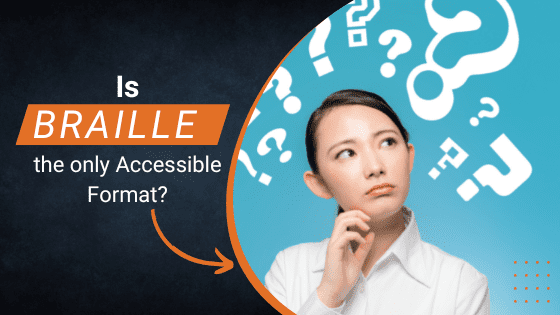Access to information is one of the key barriers faced by people with disabilities! Accessible format or alternate format is a broad term to ensure that the information, book, file, video, audio or any content that you provide is accessible to people with disabilities also.
In simple terms, it means providing information access in the format that is readable, usable and as per the needs of the person.
Some commonly used terms on accessible format are:
- Large Print – Text which is a minimum of 16 point size or larger based on the needs of the person.
- Braille – There are two types of Braille – Grade 1 and Grade 2. In Grade 1, each braille cell represents only one letter, number or punctuation sign. In Grade 2, a cell can represent a shortened form of a word. Many cell combinations have been created as contractions to represent common words.
- Audio – Using Audio formats like .wav or .mp3 formats often in human voice or synthesized text-to-speech voices. In addition, softwares like screen readers and reading writing tools, convert text to speech for the users.
- Easy Read – Simple and plain English is used. In addition, short sentences are used. Often, pictures are used to illustrate sentences.
It is important to also remember how the information is being delivered and the technology being used. So is the delivery format, print or electronic or both. Is the technology you are using to deliver, PDF, Word, PowerPoint, etc. Let’s discuss some scenarios to understand this better.
Scenario 1
For are an insurance company providing a brochure as a printed document & as PDF document on your website, the accessible formats that you could provide would be large print and braille for someone looking for the printed content. If someone wants the electronic version, then the PDF document needs to be accessible so it can be read with a screen reader or other assistive technology.
Scenario 2
If you are a book publisher, then the accessible format you would provide is the large print and braille. If you are also providing an e-book, then you would provide an accessible Epub 3 e-book.
Scenario 3
If you are a teacher providing lecture notes to your students as PowerPoint slides, you would ensure that the PowerPoint file is accessible.
Some references:
